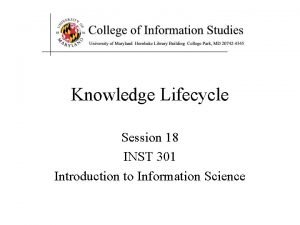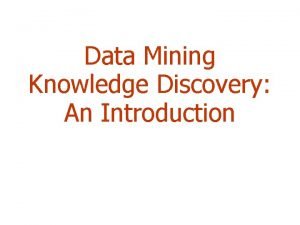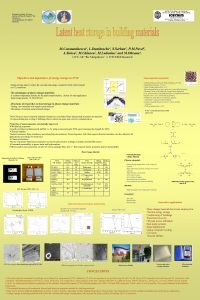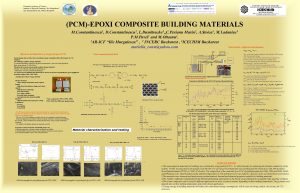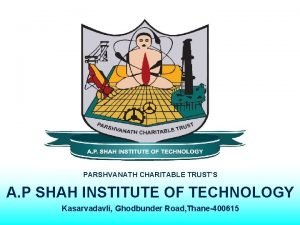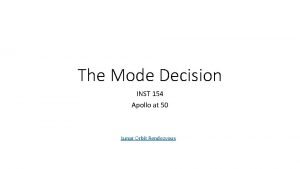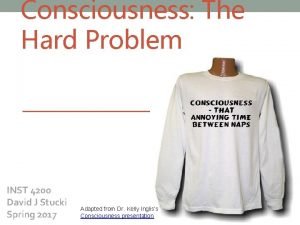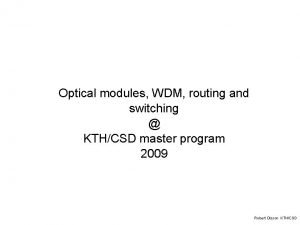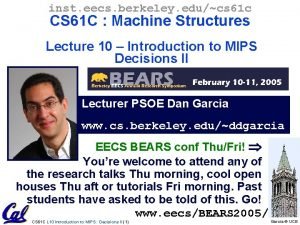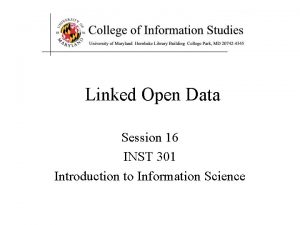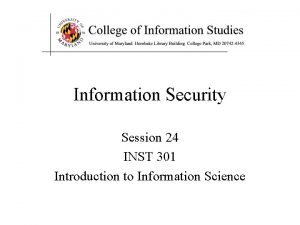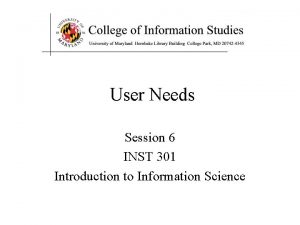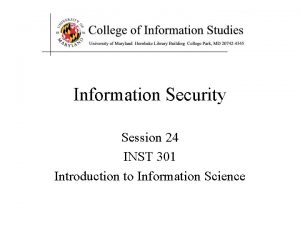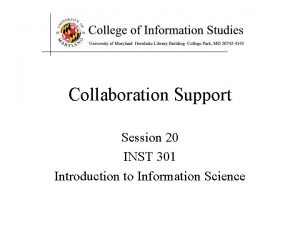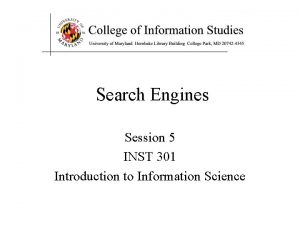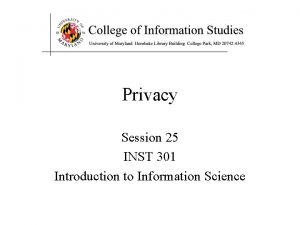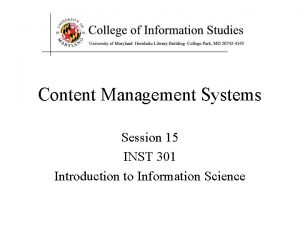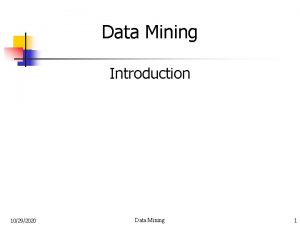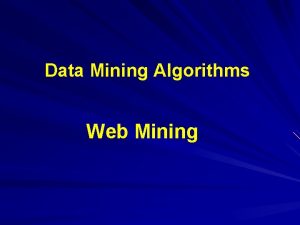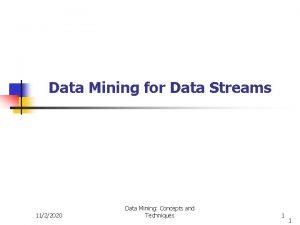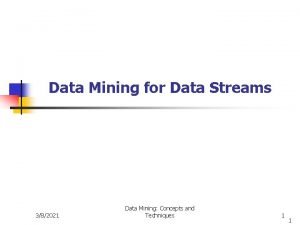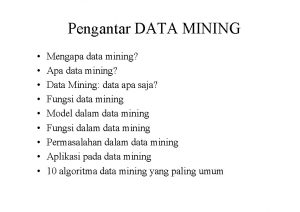Data Mining Session 17 INST 301 Introduction to






























- Slides: 30

Data Mining Session 17 INST 301 Introduction to Information Science

Agenda • Visualization • Data mining • Supervised machine learning

Starfield Visualization


Constructing Starfield Displays • Two attributes determine the position – Can be dynamically selected from a list • Numeric position attributes work best – Date, length, rating, … • Other attributes can affect the display – Displayed as color, size, shape, orientation, … • Each point can represent a cluster – Interactively specified using “dynamic queries”

Projection • Depict many numeric attributes in 2 dimensions – While preserving important spatial relationships • Typically based on the vector space model – Which has about 100, 000 numeric attributes! • Approximates multidimensional scaling – Heuristics approaches are reasonably fast • Often visualized as a starfield – But the dimensions lack any particular meaning


Contour Map Display • Display a cluster density as terrain elevation – Fit a smooth opaque surface to the data • Visualize in three dimensions – Project two 2 -D and allow manipulation – Use stereo glasses to create a virtual “fishtank” – Create an immersive virtual reality experience • Mead mounted stereo monitors and head tracking • “Cave” with wall projection and body tracking

Cluster Formation • Based on inter-document similarity – Computed using the cosine measure, for example • Heuristic methods can be fairly efficient – Pick any document as the first cluster “seed” – Add the most similar document to each cluster • Adding the same document will join two clusters – Check to see if each cluster should be split • Does it contain two or more fairly coherent groups? • Lots of variations on this have been tried

Agenda • Visualization Ø Data mining • Supervised machine learning

Curve Fitting


Text Data Mining

Agenda • Visualization • Data mining Ø Supervised machine learning


• • • Cute Mynah Bird Tricks Make scanned documents into e-text Make speech into e-text Make English e-text into Hindi e-text Make long e-text into short e-text Make e-text into hypertext Make e-text into metadata Make email into org charts Make pictures into captions …


http: //cogcomp. cs. illinois. edu/demo/wikify/? id=25

http: //americanhistory. si. edu/collections/search/object/nmah_516567

Lincoln’s English gold watch was purchased in the 1850 s from George Chatterton, a Springfield, Illinois, jeweler. Lincoln was not considered to be outwardly vain, but the fine gold watch was a conspicuous symbol of his success as a lawyer. The watch movement and case, as was often typical of the time, were produced separately. The movement was made in Liverpool, where a large watch industry manufactured watches of all grades. An unidentified American shop made the case. The Lincoln watch has one of the best grade movements made in England can, if in good order, keep time to within a few seconds a day. The 18 K case is of the best quality made in the US. A Hidden Message Just as news reached Washington that Confederate forces had fired on Fort Sumter on April 12, 1861, watchmaker Jonathan Dillon was repairing Abraham Lincoln's timepiece. Caught up in …

NEIL A. ARMSTRONG INTERVIEWED BY DR. STEPHEN E. AMBROSE AND DR. DOUGLAS BRINKLEY HOUSTON, TEXAS – 19 SEPTEMBER 2001 ARMSTRONG: I'd always said to colleagues and friends that one day I'd go back to the university. I've done a little teaching before. There were a lot of opportunities, but the University of Cincinnati invited me to go there as a faculty member and pretty much gave me carte blanche to do what I wanted to do. I spent nearly a decade there teaching engineering. I really enjoyed it. I love to teach. I love the kids, only they were smarter than I was, which made it a challenge. But I found the governance unexpectedly difficult, and I was poorly prepared and trained to handle some of the aspects, not the teaching, but just the—universities operate differently than the world I came from, and after doing it—and actually, I stayed in that job longer than any job I'd ever had up to that point, but I decided it was time for me to go on and try some other things. AMBROSE: Well, dealing with administrators and then dealing with your colleagues, I know—but Dwight Eisenhower was convinced to take the presidency of Columbia [University, New York] by Tom Watson when he retired as chief of staff in 1948, and he once told me, he said, "You know, I thought there was a lot of red tape in the army, then I became a college president. " He said, "I thought we used to have awful arguments in there about who to put into what position. " Have you ever been with a bunch of deans when they're talking about— ARMSTRONG: Yes. And, you know, there's a lot of constituencies, all with different perspectives, and it's quite a challenge. http: //wikipedia-miner. cms. waikato. ac. nz/demos/annotate/

Supervised Machine Learning Steven Bird et al. , Natural Language Processing, 2006

Gender Classification Example >>> classifier. show_most_informative_features(5) Most Informative Features last_letter = 'a' female : male = 38. 3 : 1. 0 last_letter = 'k' male : female = 31. 4 : 1. 0 last_letter = 'f' male : female = 15. 3 : 1. 0 last_letter = 'p' male : female = 10. 6 : 1. 0 last_letter = 'w' male : female = 10. 6 : 1. 0 >>> for (tag, guess, name) in sorted(errors): print 'correct=%-8 s guess=%-8 s name=%-30 s' correct=female guess=male name=Cindelyn. . . correct=female guess=male name=Katheryn correct=female guess=male name=Kathryn. . . correct=male guess=female name=Aldrich. . . correct=male guess=female name=Mitch. . . correct=male guess=female name=Rich. . . NLTK Naïve Bayes

Some Supervised Learning Methods • Support Vector Machine – High accuracy • k-Nearest-Neighbor – Naturally accommodates multi-class problems • Decision Tree (a form of Rule Induction) – Explainable (at least near the top of the tree) • Maximum Entropy – Accommodates correlated features

Rule Induction • Automatically derived Boolean profiles – (Hopefully) effective and easily explained • Specificity from the “perfect query” – AND terms in a document, OR the documents • Generality from a bias favoring short profiles – e. g. , penalize rules with more Boolean operators – Balanced by rewards for precision, recall, …

Statistical Classification • Represent documents as vectors – e. g. , based on TF, IDF, Length • Build a statistical model for each label – e. g. , a “vector space” • Use that model to label new instances – e. g. , by largest inner product

The k-Nearest-Neighbor Classifier

Linear Separators • Which of the linear separators is optimal? Original from Ray Mooney

Maximum Margin Classification • Implies that only “support vectors” matter; other training examples are ignorable. Original from Ray Mooney

Supervised Learning Limitations • Rare events – It can’t learn what it has never seen! • Overfitting – Too much memorization, not enough generalization • Unrepresentative training data – Reported evaluations are often very optimistic • It doesn’t know what it doesn’t know – So it always guesses some answer • Unbalanced “class frequency” – Consider this when deciding what’s good enough
 Inst 301
Inst 301 Eck
Eck Mining multimedia databases in data mining
Mining multimedia databases in data mining Introduction to data mining and data warehousing
Introduction to data mining and data warehousing Strip mining vs open pit mining
Strip mining vs open pit mining Mineral resources and mining chapter 13
Mineral resources and mining chapter 13 Difference between strip mining and open pit mining
Difference between strip mining and open pit mining Web text mining
Web text mining Introduction to data mining and knowledge discovery
Introduction to data mining and knowledge discovery Cs 412 introduction to data mining
Cs 412 introduction to data mining Azure data mining
Azure data mining Romanian banking institute
Romanian banking institute Rubiterm
Rubiterm Hresca inst
Hresca inst Ap shah moodle
Ap shah moodle Inst154
Inst154 Packing inst.
Packing inst. Inst-154
Inst-154 Inst
Inst Royal inst
Royal inst Inst eecs
Inst eecs Data reduction in data mining
Data reduction in data mining What is data mining and data warehousing
What is data mining and data warehousing What is missing data in data mining
What is missing data in data mining Data reduction in data mining
Data reduction in data mining Data reduction in data mining
Data reduction in data mining Data reduction in data mining
Data reduction in data mining Shell cube in data mining
Shell cube in data mining Data reduction in data mining
Data reduction in data mining Perbedaan data warehouse dan data mining
Perbedaan data warehouse dan data mining Data mining dan data warehouse
Data mining dan data warehouse
